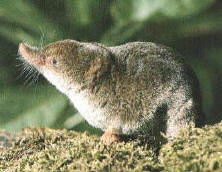Poisonous Mammals in Your Backyard
(8/3/2001)
There are only a handful of poisonous mammals in the world, but if you live
in the eastern United States, chances are good that one of them, the
Short-Tailed Shrew, is on the prowl within a hundred yards of where you sit.
The Northern Short-Tailed Shrew and its close cousin, the Southern
Short-Tailed Shrew are common throughout the Northeast in almost all habitats,
including backyards, but there's no cause to jump up and move to higher ground.
Though it is the largest shrew in North America, the Short-Tailed Shrew is still
a very small  creature,
about 4 inches in length including the "short-tail," and weighing less than an
ounce. It is slate gray, with short legs and a less pointed nose than most
shrews. If you saw one, you might very well mistake it for a mouse. creature,
about 4 inches in length including the "short-tail," and weighing less than an
ounce. It is slate gray, with short legs and a less pointed nose than most
shrews. If you saw one, you might very well mistake it for a mouse.
If you mistook it for a mouse, it probably wouldn't cause you any great harm,
since no human being has ever been recorded as dying from shrew venom. But if
you were an insect or earthworm, or even a mouse, you would be well-advised not
to make a mistake about a Short-Tailed Shrew.
Shrews in general are among the world's most ferocious and insatiable
predators and the Short-Tailed Shrew is no exception. Because of its high
metabolism, a Short-Tailed Shrew will often eat its weight or more each day.
Kate Doyle, a mammalogist at the University of Massachusetts who has trapped and
studied Short-Tailed Shrews says, "We should be glad they're not bigger, because
they eat everything!"
The Short-Tailed Shrew is a frenetic hunter, active most of the day,
searching for prey through leaf litter and in the underground tunnels of voles
and moles. Watching it hunt, it's easy to imagine that somewhere a clock is
ticking and time is about to run out.
In fact, shrews almost constantly are living with time running out. A
Short-Tailed Shrew can't go more than a few hours without food before its energy
stores are used up and it starves to death.
The endless need to eat may be the reason the Short-Tailed Shrew has evolved
venom. Not, however, because they need it to kill their prey. Short-Tailed
Shrews and other shrews that don't have venom are perfectly capable of killing
their prey simply by biting it repeatedly. Something else must be going on.
Dr. Kenneth Kardong at Washington State University Pullman, a biologist who
studies the evolution of venom, particularly in snakes, points out that use of
venom to rapidly kill prey is rare in the world of vertebrates. When I asked him
why he thought more mammals hadn't evolved what seems like a good weapon, he
suggested most mammals don't need venom.
"They have other weapons. Strong jaws, claws, high mobility, etc. Snakes
don't have those same weapons. That's why they need venom. For the most part,
mammals don't."
The salivary secretion the Short-Tailed Shrew works into its bite is
chemically similar to that of a cobra. It contains hemotoxins that lower blood
pressure and cause circulatory problems, and neurotoxins that cause paralysis. 
When a cobra uses this type of venom, the object is to kill and kill quickly.
The venom used by Short-Tailed Shrews certainly helps them kill prey, but its
main purpose may be something else.
Shrews in captivity that are fed a large number of insects at once often bite
them all, take them back to their nest, and hoard them. The insects are
paralyzed, but can remain alive for 3-5 days.
This allows a Short-Tailed Shrew to store food for the times when it can't
find new prey and its starvation clock is running out. It simply returns to its
nest and raids the refrigerator.
This may be especially important in winter. Short-Tailed Shrews are active
all winter long, and though insects, grubs, and worms are often still plentiful
under the ground, they may be less evenly distributed. If a shrew comes across
an abundance of prey, it may be advantageous to be able to capture and store
that prey alive and paralyzed in case the shrew can't find something to eat
later.
According to Dr. Joseph Merritt, an expert on the Short-Tailed Shrew who
studies winter survival of mammals at the Powdermill Biological Station in
Rector, PA, the Short-Tailed Shrew is one of the few mammals that actually gains
weight in the winter. With adequate prey, the ability to cache food, and no
breeding responsibilities, Short-Tailed Shrews fatten up under the snow and
burst into spring ready to mate and breed in late March.
As for having these interesting, though poisonous, mammals in your yard,
there's little to worry about. Though Short-Tailed Shrews can often be the most
common small mammals in this part of the country, even more common than mice or
voles, people rarely encounter them and are even more rarely bitten.
Short-Tailed Shrews spend most of their time underground, and even if you
meet a Short-Tailed Shrew above ground, it'll most likely run away.
Dr. Merritt has been bitten several times when handling Short-Tailed Shrews
with little more reaction than a bee sting. But he remembers one student who was
bitten on the hand by a particularly angry shrew that had to be pried loose. The
student's arm became swollen and painful and showed signs of internal bruising
that lasted more than a week.
So it's wise to be respectful of this tiny, but successful little hunter. Be
thankful that their ferocious appetite -- and their venom -- is applied mainly
to insects.
|